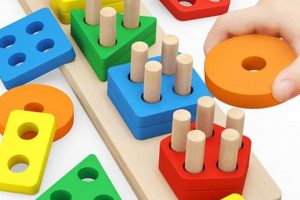Materials designed for very young children following the Montessori philosophy emphasize natural materials, simple designs, and opportunities for independent exploration. These learning tools typically focus on sensory development, practical life skills, and early language acquisition. Examples include grasping toys made of wood or fabric, mobiles featuring contrasting colors or patterns, and simple puzzles with large pieces.
The emphasis on self-directed learning fosters concentration, problem-solving skills, and a love of learning. By providing infants with opportunities to manipulate objects and discover relationships independently, these materials support their natural curiosity and cognitive development from an early age. Rooted in Dr. Maria Montessori’s observations of children, this approach recognizes the absorbent mind of the infant and its capacity to internalize knowledge from the surrounding environment. This approach respects the child’s developmental stages, offering age-appropriate challenges that encourage growth and self-confidence.
This exploration will delve further into specific categories of these enriching materials, offering guidance on selection, usage, and the developmental benefits they provide. Further topics will cover adapting the Montessori method for home environments, understanding the developmental stages of infancy, and selecting appropriate materials for each stage.
Tips for Utilizing Montessori-Inspired Materials for Infants
Appropriate material selection and usage are crucial for maximizing the benefits of a Montessori approach during infancy. The following tips offer practical guidance for caregivers.
Tip 1: Prioritize Natural Materials: Opt for toys crafted from natural materials like wood, cotton, or silk. These offer varied tactile experiences and are generally safer and more sustainable than plastic alternatives.
Tip 2: Keep it Simple: Choose toys with simple designs that focus on a single skill or concept. Avoid overstimulating infants with toys that have flashing lights, loud sounds, or excessive features.
Tip 3: Observe the Child’s Interests: Careful observation allows caregivers to offer materials aligned with the child’s current developmental stage and interests, promoting engagement and deeper learning. Rotate materials periodically to maintain novelty and prevent boredom.
Tip 4: Focus on Real-World Experiences: Introduce materials that mimic everyday objects and activities, such as soft balls, wooden blocks, or simple puzzles. These help bridge the gap between play and real-world application.
Tip 5: Encourage Independent Exploration: Provide a safe and prepared environment where infants can freely explore materials at their own pace. Avoid interrupting or directing their play unless necessary.
Tip 6: Less is More: Offer a limited number of toys at a time to avoid overwhelming the child and to encourage focused attention. A carefully curated selection promotes deeper engagement than a large, disorganized collection.
Tip 7: Consider Developmental Stages: Recognize that infants progress through different developmental stages, each with unique needs and interests. Choose materials that align with the child’s current stage, offering appropriate challenges and promoting optimal development.
By following these guidelines, caregivers can create enriching environments that support infants’ natural curiosity and developmental progress. These practices cultivate concentration, problem-solving skills, and a lifelong love of learning.
Implementing these strategies within a prepared environment fosters a supportive foundation for the child’s continued growth and exploration throughout childhood. The focus on self-directed learning and exploration encourages independence and a sense of self-efficacy.
1. Natural Materials
Natural materials are fundamental to the Montessori philosophy for infants. They offer multi-sensory experiences that stimulate a child’s developing senses of touch, sight, and smell. Unlike synthetic materials, natural resources like wood, cotton, silk, and wool possess unique textures, scents, and even subtle variations in color, providing richer sensory input. This varied sensory input contributes significantly to an infant’s understanding of the world. Wooden rattles, for example, offer a different tactile and auditory experience compared to plastic ones. The weight, smoothness, and sound of wood contribute to a more nuanced sensory exploration.
The use of natural materials also aligns with the Montessori emphasis on respecting the environment. Sustainable and biodegradable materials foster an early appreciation for nature. Furthermore, they are generally free of harmful chemicals often found in plastics, promoting a healthier environment for infants. Exposure to natural materials can also contribute to a greater appreciation for the natural world, fostering respect for the environment from an early age. Choosing wooden blocks over plastic ones, for example, introduces the concept of natural resources and their inherent value.
In summary, the preference for natural materials in Montessori infant toys stems from their inherent sensory richness, their alignment with environmental responsibility, and their contribution to holistic development. This approach cultivates a deeper connection with the natural world and encourages a more mindful approach to learning and exploration. While procuring natural materials might sometimes present a higher initial cost, the long-term benefits for sensory development and environmental awareness justify the investment.
2. Simple Design
Simplicity in design is a cornerstone of the Montessori approach to infant materials. It stems from the understanding that infants are easily overwhelmed by excessive stimuli. A simple design allows the child to focus on a single concept or skill, promoting deeper understanding and more focused engagement. This principle avoids overstimulation and encourages exploration driven by the child’s inherent curiosity, rather than dictated by the toy’s features.
- Isolation of a Single Concept:
Montessori infant toys often isolate a single skill or concept, such as grasping, shaking, or tracking. This allows the child to master each concept individually before moving on to more complex activities. A simple wooden rattle, for example, focuses solely on grasping and sound exploration, allowing the infant to understand cause and effect without distractions. This isolation of concepts encourages deeper cognitive processing and facilitates the development of specific skills.
- Clear Purpose and Functionality:
The design clarity in Montessori materials ensures that the toy’s purpose and functionality are self-evident. This encourages independent exploration and discovery, as the child can intuitively understand how to interact with the material. A set of stacking rings, for instance, clearly presents the challenge of size gradation and encourages the child to experiment with different arrangements. This promotes problem-solving skills and fosters a sense of accomplishment.
- Absence of Distracting Features:
Montessori toys typically avoid bright colors, flashing lights, and electronic sounds, which can overstimulate and distract infants. The absence of these features allows the child to focus on the essential qualities of the material and engage in more meaningful exploration. A mobile with simple, contrasting shapes, for example, encourages visual tracking and concentration without overwhelming the infant’s sensory system. This fosters calmer, more focused attention, promoting cognitive development.
- Emphasis on Natural Exploration:
The simplicity of design encourages open-ended play and allows the child to explore the material in their own way. This fosters creativity, problem-solving skills, and a sense of autonomy. A set of wooden blocks, for example, can be stacked, arranged, or used in imaginative play, allowing the child to direct their own learning experience. This self-directed exploration contributes to a deeper understanding of the material’s properties and possibilities.
By emphasizing simple design, Montessori infant toys support focused attention, independent exploration, and a deeper understanding of fundamental concepts. This approach nurtures the child’s natural curiosity and encourages a love of learning from an early age. This foundation of focused engagement and self-directed exploration becomes crucial for later, more complex learning experiences.
3. Sensory exploration
Sensory exploration forms a cornerstone of Montessori infant materials, directly supporting neurological development and shaping a child’s understanding of the world. Infants learn primarily through their senses; therefore, materials designed to engage these senses are critical for early cognitive, physical, and emotional growth. Tactile, visual, auditory, and even olfactory and gustatory stimuli offered by appropriately designed toys create pathways for learning and form the basis for future cognitive processes. This emphasis on sensory engagement distinguishes Montessori infant materials from conventional toys often characterized by excessive stimulation or limited sensory input. The opportunity to manipulate objects with varying textures, weights, and colors, for example, aids in developing fine motor skills, hand-eye coordination, and an understanding of object permanence.
The careful selection of materials is crucial. Montessori-aligned toys typically feature natural materials like wood, cotton, and silk, which offer varied tactile experiences and subtle differences in texture and scent. These nuances stimulate the infant’s senses more effectively than uniform plastic textures. Visual stimulation is achieved through simple, high-contrast patterns and colors, supporting developing eyesight and encouraging focus. Auditory exploration is fostered through soft rattles, bells, or crinkling fabrics, which stimulate auditory processing and aid in understanding cause and effect. Even simple activities like transferring water from one container to another can offer rich sensory input and promote the development of practical life skills. Consider a textured wooden rattle; its weight, feel, and sound provide a richer, more nuanced sensory experience compared to a plastic equivalent. Similarly, a mobile with contrasting colors and shapes stimulates visual tracking and encourages focus without overwhelming the infant’s visual system.
Sensory exploration through well-designed materials lays the groundwork for future learning. By engaging multiple senses, these materials foster neurological connections crucial for cognitive development, language acquisition, and problem-solving skills. The emphasis on hands-on exploration encourages active learning and builds a foundation for a lifelong love of discovery. However, it is important to recognize that infants’ sensory thresholds vary. Careful observation is key to ensuring that offered materials provide appropriate stimulation without overwhelming the child. Further, providing a prepared environment a space free from excessive clutter and distractions allows infants to focus on their chosen materials and engage in uninterrupted exploration, maximizing the benefits of sensory learning. This approach promotes concentration, self-regulation, and a deeper connection with the surrounding environment.
4. Independent Activity
Independent activity is a central tenet of the Montessori philosophy, particularly crucial for infant development. Montessori-aligned materials are specifically designed to foster independent exploration and discovery. This approach recognizes the infant’s innate drive to learn and understand the world through direct interaction. Providing opportunities for uninterrupted engagement with carefully chosen materials allows infants to develop concentration, problem-solving skills, and a sense of self-reliance. This contrasts sharply with approaches that rely on constant adult direction or entertainment. For example, a Montessori infant might spend an extended period exploring a basket of textured balls, discovering differences in texture, weight, and size independently. This self-directed exploration fosters deeper learning and a greater sense of accomplishment than adult-led play.
The design of Montessori infant toys directly supports independent activity. Simplicity, natural materials, and clear functionality allow infants to engage with materials intuitively, without requiring constant adult intervention. A set of nesting boxes, for instance, presents a clear challenge and invites the infant to experiment with fitting the boxes together. This process fosters problem-solving skills and hand-eye coordination independently. Furthermore, the prepared environment a space free from clutter and distractions plays a vital role in promoting independent activity. A designated play area with a limited selection of age-appropriate materials allows the infant to focus and engage more deeply, fostering longer periods of concentration and independent exploration.
Cultivating independent activity in infancy yields significant long-term benefits. It fosters self-confidence, intrinsic motivation, and a love of learning. Children accustomed to self-directed exploration are more likely to approach new challenges with curiosity and persistence. This foundation of independent learning established in infancy sets the stage for continued academic and personal success. However, supporting independent activity requires careful observation and adaptation to the individual child’s developmental needs. While independence is encouraged, caregivers must remain attentive and responsive, providing support and guidance when necessary, ensuring a balance between freedom and security.
5. Real-world connection
Montessori infant materials emphasize a connection to real-world experiences, bridging the gap between play and practical life. This connection fosters a deeper understanding of the environment and encourages the development of essential life skills from an early age. Rather than presenting abstract concepts or fantastical characters, these materials often reflect everyday objects and activities. This grounded approach allows infants to connect their play experiences to the world around them, promoting a more meaningful understanding of their environment. Miniature versions of household objects, such as wooden brooms, brushes, or sorting containers, encourage imitation and lay the groundwork for practical life skills. Similarly, toys that involve manipulating real-world materials, like pouring water or stacking wooden blocks, develop fine motor control and problem-solving abilities applicable to everyday tasks.
This real-world connection facilitates the development of essential skills and fosters a sense of purpose and accomplishment. Activities like pouring, scooping, and transferring objects, while seemingly simple, refine hand-eye coordination, concentration, and independent problem-solving skills directly transferable to practical tasks. For example, the experience of pouring water from a small pitcher into a cup not only refines motor control but also introduces concepts of volume and capacity. Similarly, sorting objects by size or color develops early mathematical reasoning and organizational skills applicable in various real-world contexts. This connection to practical life encourages a deeper engagement with the materials and fosters a sense of competence and self-reliance. By mirroring activities found in daily life, these materials instill a sense of purpose and meaning in the child’s play, making learning more relevant and engaging.
Connecting play to real-world experiences lays a strong foundation for future learning and development. By engaging with materials that reflect their environment, infants develop a deeper understanding of the world and their place within it. This early connection fosters a sense of order and predictability, contributing to a sense of security and confidence. Further, the emphasis on practical life skills encourages independence and self-sufficiency, empowering infants to actively participate in their daily routines. This approach promotes not only practical competence but also a positive self-image and a lifelong love of learning through real-world application. The transition from playful exploration to practical application becomes seamless, fostering a deeper understanding and appreciation for the interconnectedness of learning and life.
Frequently Asked Questions about Montessori Infant Materials
This section addresses common inquiries regarding Montessori-aligned materials for infants, aiming to provide clarity and practical guidance for caregivers.
Question 1: What is the ideal age to introduce Montessori materials to infants?
While there is no strict starting age, many caregivers begin incorporating Montessori principles from birth. Newborns can benefit from simple mobiles designed to stimulate visual tracking. As infants grow, materials can be introduced progressively, aligned with their developmental stage and emerging abilities.
Question 2: How do Montessori infant toys differ from conventional toys?
Montessori infant materials typically prioritize natural materials, simple design, and opportunities for independent exploration. They often focus on a single skill or concept, avoiding the overstimulation common in many conventional toys featuring flashing lights, loud sounds, and excessive features. The emphasis is on quality over quantity, fostering deeper engagement and meaningful learning experiences.
Question 3: Are Montessori toys expensive?
While some specialized Montessori materials can be costly, many affordable options and DIY alternatives exist. Prioritizing natural materials and simple designs often allows for cost-effective choices. Adapting everyday household items can also provide enriching, Montessori-aligned experiences without significant expense.
Question 4: How many toys should an infant have at a time?
A curated selection of a few toys at a time is generally recommended. Rotating toys periodically helps maintain novelty and prevents overstimulation. This approach encourages focused attention and deeper engagement with each material, supporting optimal learning.
Question 5: How can I create a Montessori-inspired environment at home?
Creating a prepared environment at home involves establishing a dedicated space free from clutter and distractions. Low shelves stocked with a limited selection of age-appropriate materials allow infants to choose and explore independently. Organizing the space to facilitate independent access and return of materials fosters self-reliance and a sense of order.
Question 6: How do I know if a toy is truly Montessori aligned?
While official certification exists for Montessori educators and schools, no such certification exists for toys. Look for materials that emphasize natural materials, simple design, and opportunities for independent exploration and manipulation. Consider whether the toy supports a specific skill or concept and encourages the child’s active engagement.
Understanding these core principles allows caregivers to make informed decisions about selecting and utilizing Montessori-inspired materials to create enriching learning experiences for infants. This investment in early development fosters a strong foundation for lifelong learning and a genuine love of discovery.
For further information, explore the subsequent sections detailing specific categories of Montessori infant materials and their developmental benefits.
Montessori Infant Materials
This exploration has highlighted the core principles and benefits of Montessori-aligned materials for infants. From the emphasis on natural materials and simple design to the focus on sensory exploration, independent activity, and real-world connections, these materials offer a unique approach to early childhood development. By providing infants with opportunities for self-directed learning and exploration, these materials foster essential skills, including concentration, problem-solving, and a love of learning. The careful selection and utilization of these materials within a prepared environment create a supportive foundation for infants cognitive, physical, and emotional growth.
Investing in quality infant materials aligned with the Montessori philosophy represents an investment in a child’s future. These materials empower infants to become active learners, engaged explorers, and confident individuals. The emphasis on self-discovery and hands-on learning cultivates a lifelong love of learning and lays the groundwork for continued growth and development throughout childhood and beyond. Continued exploration of Montessori principles and their application in the home environment can further enhance a child’s developmental journey.







